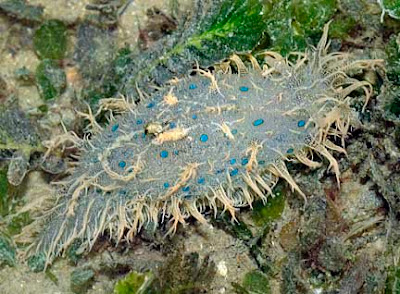
Like many other sea hares, these animals are seasonal. They are seen in large numbers for a short period of time, and then none are seen for a long time.
 Like other sea hares, they have two pairs of tentacles. Although the 'hairy' bits on this sea hare makes it difficult to distinguish them. The front pair (called oral tentacles) are next to the mouth. The second pair (called rhinophores) is further behind on top of the 'head' and usually smaller. The tentacles are made up of rolled tubes containing chemical sensors.
Like other sea hares, they have two pairs of tentacles. Although the 'hairy' bits on this sea hare makes it difficult to distinguish them. The front pair (called oral tentacles) are next to the mouth. The second pair (called rhinophores) is further behind on top of the 'head' and usually smaller. The tentacles are made up of rolled tubes containing chemical sensors.These sea hares come in a variety of colours.
 Some are pale. But they all have these broad 'hairy' bits and bright blue spots.
Some are pale. But they all have these broad 'hairy' bits and bright blue spots. Another of the 'blonde' ones. They are not quite as commonly seen as the darker ones.
Another of the 'blonde' ones. They are not quite as commonly seen as the darker ones. Like other large sea hares on our shores, they are often seen half buried in the sand.
Like other large sea hares on our shores, they are often seen half buried in the sand. When distressed, sea hares may release a purple pigment. The function of this dye is not known. Unlike an octopus or squid, it doesn't form a screen for a quick escape as most of these slugs usually don't move very fast. One study found that the dye irriates other animals such as crabs, sea urchins, fishes and bristleworms. It is believed that the dye is a by-product of the seaweeds that the sea hare eats.
When distressed, sea hares may release a purple pigment. The function of this dye is not known. Unlike an octopus or squid, it doesn't form a screen for a quick escape as most of these slugs usually don't move very fast. One study found that the dye irriates other animals such as crabs, sea urchins, fishes and bristleworms. It is believed that the dye is a by-product of the seaweeds that the sea hare eats. There were clusters of several individuals squished together, here and there. Hmm. Are they gathering at a good food source, or making new sea hares?
There were clusters of several individuals squished together, here and there. Hmm. Are they gathering at a good food source, or making new sea hares? This pair seems to be seriously cuddling up. But all the 'hairy' bits make it very difficult to see what exactly is going on.
This pair seems to be seriously cuddling up. But all the 'hairy' bits make it very difficult to see what exactly is going on. And indeed, there were lots of clumps of these pink strings that look like noodles. These are probably the eggs of a sea hare. But which one? I have no idea because there were other kinds of sea hares on the shores too!
And indeed, there were lots of clumps of these pink strings that look like noodles. These are probably the eggs of a sea hare. But which one? I have no idea because there were other kinds of sea hares on the shores too! There were a few large Geographic seahares (Syphonota geographica), but not as many as on another Changi shore that we visited yesterday. Sea hares have their body in two flaps, and an internal shell, as can be seen in the above photo.
There were a few large Geographic seahares (Syphonota geographica), but not as many as on another Changi shore that we visited yesterday. Sea hares have their body in two flaps, and an internal shell, as can be seen in the above photo. And then, there was this sea hare that is also hairy but is something else altogether! This the Furry sea hare (Stylocheilus sp.). Compared to the Hairy sea hare, it has smaller 'hairy' bits, so much so that its pair of tentacles are more easily distinguished. While it also has blue spots, these are smaller. And it has fine stripes along the body. I've often seen this slug when the Hairy sea hares are in season.
And then, there was this sea hare that is also hairy but is something else altogether! This the Furry sea hare (Stylocheilus sp.). Compared to the Hairy sea hare, it has smaller 'hairy' bits, so much so that its pair of tentacles are more easily distinguished. While it also has blue spots, these are smaller. And it has fine stripes along the body. I've often seen this slug when the Hairy sea hares are in season.Why are they called hares? I don't really know. Perhaps it is because sea hares do move rather quickly, for a slug anyway. With some imagination, the tentacles on their head do kind of resemble the ears of a rabbit. Also, they are herbivores, eating seaweed.
Whatever the reason, I do think they are quite fascinating. And while they are in season, we often get irritated by their overwhelming presence. But we miss them when they are out of season.
Here's more about fishes and other sightings, and crabs seen on Changi today.
